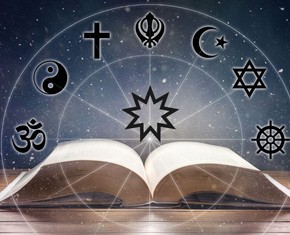The views expressed in our content reflect individual perspectives and do not represent the authoritative views of the Baha'i Faith.
…by religion is meant that which is ascertained by investigation and not that which is based on mere imitation, the foundation of divine religions and not human imitations. – Abdu’l-Baha, Foundations of World Unity, p. 30.
The age-old question for seekers has always been: “How do I tell truth from falsehood?” Now, because of the proliferation of damaging, dangerous cults, that question has become even more important. When you’re searching, you need a set of criteria that will help you separate real, healthy, authentic belief systems from their opposites.
The Baha’i teachings have several suggestions for spiritual seekers who want to separate spiritual truth from fiction. First, they advise us to avoid “dogmatic imitations of ancestral beliefs:”
This is the cycle of maturity and re-formation in religion as well. Dogmatic imitations of ancestral beliefs are passing. They have been the axis around which religion revolved but now are no longer fruitful; on the contrary, in this day they have become the cause of human degradation and hindrance. Bigotry and dogmatic adherence to ancient beliefs have become the central and fundamental source of animosity among men, the obstacle to human progress, the cause of warfare and strife, the destroyer of peace, composure and welfare in the world… These conditions are the outcome of hostility and hatred between nations and peoples of religion who imitate and adhere to the forms and violate the spirit and reality of the divine teachings. – Abdu’l-Baha, Foundations of World Unity, p. 10.
Second, the Baha’i teachings say, look for beliefs that emphasize unity rather than separateness:
All the holy Manifestations of God have proclaimed and promulgated the same reality. They have summoned mankind to reality itself and reality is one. The clouds and mists of imitations have obscured the Sun of Truth. We must forsake these imitations, dispel these clouds and mists and free the Sun from the darkness of superstition. Then will the Sun of Truth shine most gloriously; then all the inhabitants of the world will be united, the religions will be one, sects and denominations will reconcile, all nationalities will flow together in the recognition of one fatherhood and all degrees of humankind gather in the shelter of the same tabernacle, under the same banner. – Ibid., p. 13.
Third, the Baha’i teachings recommend, focus on the light and not the lamp:
…we must follow and adore the virtues revealed in the Messengers of God — whether in Abraham, Moses, Jesus or other Prophets — but we must not adhere to and adore the lamp. We must recognize the sun, no matter from what dawning point it may shine forth, be it Mosaic, Abrahamic or any personal point of orientation whatever, for we are lovers of sunlight and not of orientation. We are lovers of illumination and not of lamps and candles. We are seekers for water, no matter from what rock it may gush forth. We are in need of fruit in whatsoever orchard it may be ripened. We long for rain; it matters not which cloud pours it down. We must not be fettered. If we renounce these fetters, we shall agree, for all are seekers of reality. The counterfeit or imitation of true religion has adulterated human belief, and the foundations have been lost sight of. The variance of these imitations has produced enmity and strife, war and bloodshed. Now the glorious and brilliant twentieth century has dawned, and the divine bounty is radiating universally. The Sun of Truth is shining forth in intense enkindlement. This is, verily, the century when these imitations must be forsaken, superstitions abandoned and God alone worshiped. We must look at the reality of the Prophets and Their teachings in order that we may agree. – Abdu’l-Baha, The Promulgation of Universal Peace, pp. 152-153.
Fourth: gauge the truth of any belief system by the love and unity it produces. If it encourages separateness from others, takes away individual autonomy or promotes division and hatred between people, it has no basis in spiritual reality:
True religion is the source of love and agreement amongst men, the cause of the development of praiseworthy qualities, but the people are holding to the counterfeit and imitation, negligent of the reality which unifies, so they are bereft and deprived of the radiance of religion. They follow superstitions inherited from their fathers and ancestors. To such an extent has this prevailed that they have taken away the heavenly light of divine truth and sit in the darkness of imitations and imaginations. – Ibid., p. 179.
Finally, the Baha’i teachings recommend that true faith must fill the heart with love for God and love for humanity, making the seeker’s face shine, and the whole being radiant with joy:
Only when the lamp of search, of earnest striving, of longing desire, of passionate devotion, of fervid love, of rapture, and ecstasy, is kindled within the seeker’s heart, and the breeze of His loving-kindness is wafted upon his soul, will the darkness of error be dispelled, the mists of doubts and misgivings be dissipated, and the lights of knowledge and certitude envelop his being. – Baha’u’llah, Gleanings from the Writings of Baha’u’llah, p. 26.
Next: The Promises of God Have All Been Fulfilled
You May Also Like
Comments

















I love this authenticity series. ...As a student of Existentialism, I have always been concerned with the issue of authenticity. I have also read articles on Tricycle about being an authentic Buddhist.
Authenticity is a big them in the Threefold Lotus Sutra (Innumerable Meaings Sutra, Lotus Sutra, Samantabhadra Meditation Sutra) and Gosho (writings of Nichiren Daishonin) as well as Nichiren Buddhism (of which Soka Gakkai International and Soka Gakkai are forms of). The SGI Dictionary of Buddhism is another good read in addition to the Threefold Lotus Sutra and Gosho. Nichiren Buddhism Library dot com has them for free online for everyone to be able to read.
The ten paramitas (perfections) of Mahayana Buddhism lead to the ten bhumis (grounds "of enlightenment). All parts of the list of a religion, versus a cult, involve them. Wikipedia articles on them list all twenty which I don't need to list here because it's a long list to type.
This is why the Vatican, and other religious institutions, reserve the majority of donations for new temple accounts.
Sadly, the Church donates less than 5% of its income to charities.
and zero to emergency relief organizations.
The difference between a cult and religion is real estate.
The Catholic Church came to this realization centuries ago, other religious institutions simply followed.